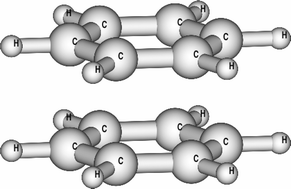A new implementation of the scaled opposite spin Møller–Plesset (SOS-MP2) method is briefly described, which exploits the locality and sparsity of expansion coefficients and as a result has computational costs that increase approximately quadratically with molecular size. The performance of SOS-MP2 for describing stacked π-complexes is carefully investigated using the benzene, ethylene, uracil, and naphthalene dimers as model systems. It is demonstrated that counterpoise-corrected SOS-MP2 results, extrapolated towards the complete basis set (CBS) limit using a two-point extrapolation scheme, can yield association energies that are reasonably close to the best available numbers, when the single scale factor is chosen as 1.55 for extrapolating results at the cc-pVDZ and cc-pVTZ levels. This methodology yields an interaction energy for the fullerene–tetraphenylporphyrin dimer of −31.47 kcal mol−1 while Hartree–Fock (HF) with the cc-pVTZ basis finds the dimer at the same geometry is unbound by +10.83 kcal mol−1. This implies that the net binding is a result of substantial correlation effects, presumably long-range London dispersions.

You have access to this article
 Please wait while we load your content...
Something went wrong. Try again?
Please wait while we load your content...
Something went wrong. Try again?


 Please wait while we load your content...
Please wait while we load your content...